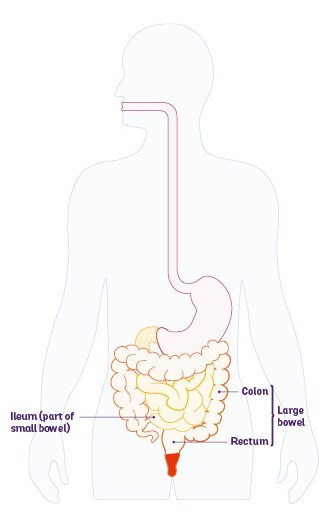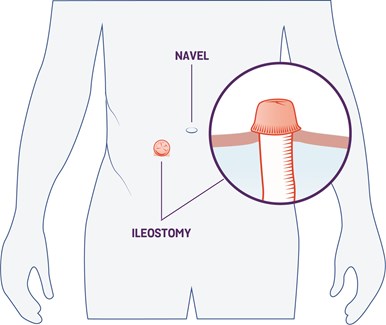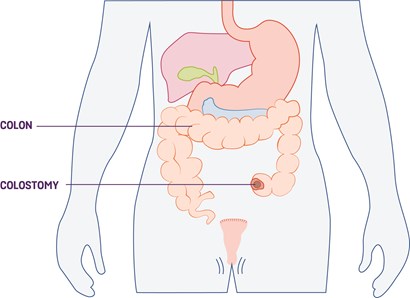When you are pregnant, your stoma might change size or shape. Some women develop a hernia or prolapse when they are pregnant. A hernia is a bulge under the skin around your stoma. It happens if some of your bowel pushes through the gap in your tummy muscles around your stoma. A prolapse is when part of your bowel sticks out of your stoma.
Rarely, your stoma might get blocked during your pregnancy. Your stoma nurse will tell you what to look out for and when to get advice.
Some people who have a stoma give birth vaginally. But around 3 in 4 have a caesarean section. This is usually planned. Emergency caesareans are no more common in women with a stoma than in women without. Your team will talk to you about the best option for you.
Babies born to women who have a stoma are usually healthy. But they are more likely to be born early and to be smaller than babies born to other women. This might be due to Crohn’s or Colitis flare-ups.
You are not likely to get a stoma when you are pregnant unless you need surgery urgently. If this is the case, you will only have surgery if your Crohn’s or Colitis is a greater risk to your baby than the surgery.
You can find out more in our information on pregnancy and birth.
If you want to have sex but not get pregnant, you can think about what contraception to use. If you have only a small section of bowel left, or you have a high stoma output, you might not absorb tablets properly. This means that contraceptive tablets might not work. But there are many other types of contraception that may suit you. For more details, our information on sex and relationships covers contraception choices.
Exercise and physical activity
When you go home after surgery, you will probably be able to walk around and do light tasks. You will feel tired to start with, but gentle exercise can help build up your energy levels.
Once you have recovered from surgery, your stoma nurse or physiotherapist might give you exercises to build up your tummy muscles. This helps prevent a hernia. A hernia is when some of your bowel pushes through the gap in your muscles where you had surgery and causes a bulge under the skin.
Having a stoma should not stop you doing the exercise you enjoy. In fact, many people find they can go back to doing the things they used to before their operation. Build up the amount of exercise you do gradually. Do not rush or expect too much of yourself too quickly. For heavier activities, you could wear a belt or girdle to support your stoma and tummy muscles. Your stoma nurse can tell you when you can start playing contact sports again.
Stoma bags are waterproof, so you can go swimming if you want to. You can get filter covers to stop the filters getting wet. Some people like to use a smaller stoma bag when swimming. If you want to cover up your stoma bag, you can buy covers in different colours and patterns. You can also get swimwear that is specially designed for people who have a stoma.
Colostomy UK have more information in their booklet: Active Ostomates- Sport and fitness after stoma surgery.
Work
If you are going back to work after having a stoma, it’s a good idea to talk to your employer about how they can support you. Some people worry how their employer or colleagues might react if they tell them they have a stoma. But most people find that telling people helps them understand their needs.
You might have had a long time off work before having your stoma. You might be looking forward to returning. But you might also feel anxious. When you first go back, you could ask for a phased return. Or you could ask for lighter duties to begin with. Some people work out a routine that means they do not have to change their bag too often at work.
If you have a stoma, you might be classed as disabled under UK law. See the section on stomas and being classed as disabled for more information. If you are classed as disabled, your employer has a duty to make reasonable adjustments. You can find out more about reasonable adjustments in our guide for employees. We also have a guide for employers, which you could show your manager or HR department.
Education
If you or your child are returning to education after having a stoma, you may want to contact staff to discuss what support you need, or your child needs. You might find our information for schools, colleges and universities helpful. Colostomy UK have a young ostomates section on their website. This contains resources for young people and parents affected by stoma surgery.
Travel
Having a stoma should not stop you travelling, but it takes a bit more planning. Often people find that travelling is easier with a stoma than it was when they had Crohn’s or Colitis symptoms. Ask your surgical team how long you should wait after your stoma surgery before it is safe to drive. You should also check with your car insurance company. If you are travelling as a passenger, it’s sensible to make sure you can move around easily and sit comfortably before going on a trip.
The UK Civil Aviation Authority recommends that you do not fly for 10 days after having abdominal surgery.
We have more information about travelling with Crohn’s or Colitis, which covers holidays, business trips and longer travel. It includes information for people who have a stoma.
Taking medicines
If you have a stoma, your body might not fully absorb tablets or capsules. Instead, they might pass straight through your gut and come out into your stoma bag. Slow-release tablets and capsules are not suitable for people who have a stoma. Liquids, uncoated tablets or tablets that dissolve in water may work better. Your GP or pharmacist can advise you on what medicines are suitable for you.
Cancer screening
If you have any of your large bowel left after your stoma surgery, you could get Crohn’s or Colitis in the remaining bowel. There is also a chance you could get cancer in the bowel you have left. This means you might still need to have colonoscopies. In this case, you would have the colonoscopy through your stoma instead of through your bottom. Colostomy UK have a booklet about having a colonoscopy through a stoma (PDF).
We have separate information on the risk of bowel cancer in people living with Crohn’s or Colitis.
If you receive a bowel cancer screening test by post, also called a ‘FIT’ test, call the government’s free helpline on 0800 707 6060. They can check whether it is appropriate for you to do it. If you cannot call the government helpline, you could ask your GP.
Dementia and having a stoma
People who have a stoma can also have other health conditions. This might affect their ability to manage their stoma. For example, having dementia can make it hard to look after a stoma.












